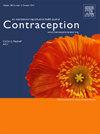Male contraception – Part of gender medicine and reproductive rights of men
IF 2.8
2区 医学
Q1 OBSTETRICS & GYNECOLOGY
引用次数: 0
Abstract
A pregnancy is in general the result of the sexual interaction of two individuals, with either different or same genders (male, female, non-binary etc). Preventing an unwanted pregnancy is therefore basically a “joint preventive behavior”, which can be achieved by gender specific behaviors with gender specific methods in a specific sociocultural environment. This sociocultural environment (circumstances) determines the frame of gender specific behaviors (reproductive rights) and the available gender specific contraceptive methods (contraceptive technology). In the sociocultural history of contraception different models of contraceptive practice evolved from the patriarchal to the female emancipation model, with different balances and imbalances regarding these two basic components. Based on the concept of the “joint preventive behavior” not only reproductive rights including reproductive responsibilities, but also contraceptive choices should be as equally balanced as possible, to allow collaboration between two individuals involved in reproduction. The development and the broad availability of different male contraceptive methods allowing individualization and best fit between the method and the individual profile, will be an important way forward to achieve this goal.
男性避孕--性别医学和男性生殖权利的一部分。
因此,防止意外怀孕基本上是一种 "联合预防行为",可以通过在特定社会文化环境中使用特定性别方法的特定性别行为来实现。这种社会文化环境(环境)决定了性别特定行为(生育权)的框架和可用的性别特定避孕方法(避孕技术)。在避孕的社会文化历史中,从父权模式到女性解放模式,避孕实践演化出不同的模式,这两个基本组成部分之间存在着不同的平衡和失衡。基于 "共同预防行为 "的概念,不仅生殖权利(包括生殖责任),而且避孕选择也应尽可能平衡,使参与生殖的两个人能够合作。开发并广泛提供不同的男性避孕方法,实现方法与个人情况的个性化和最佳匹配,将是实现这一目标的重要途径。
本文章由计算机程序翻译,如有差异,请以英文原文为准。
求助全文
约1分钟内获得全文
求助全文
来源期刊

Contraception
医学-妇产科学
CiteScore
4.70
自引率
17.20%
发文量
211
审稿时长
69 days
期刊介绍:
Contraception has an open access mirror journal Contraception: X, sharing the same aims and scope, editorial team, submission system and rigorous peer review.
The journal Contraception wishes to advance reproductive health through the rapid publication of the best and most interesting new scholarship regarding contraception and related fields such as abortion. The journal welcomes manuscripts from investigators working in the laboratory, clinical and social sciences, as well as public health and health professions education.
 求助内容:
求助内容: 应助结果提醒方式:
应助结果提醒方式:


